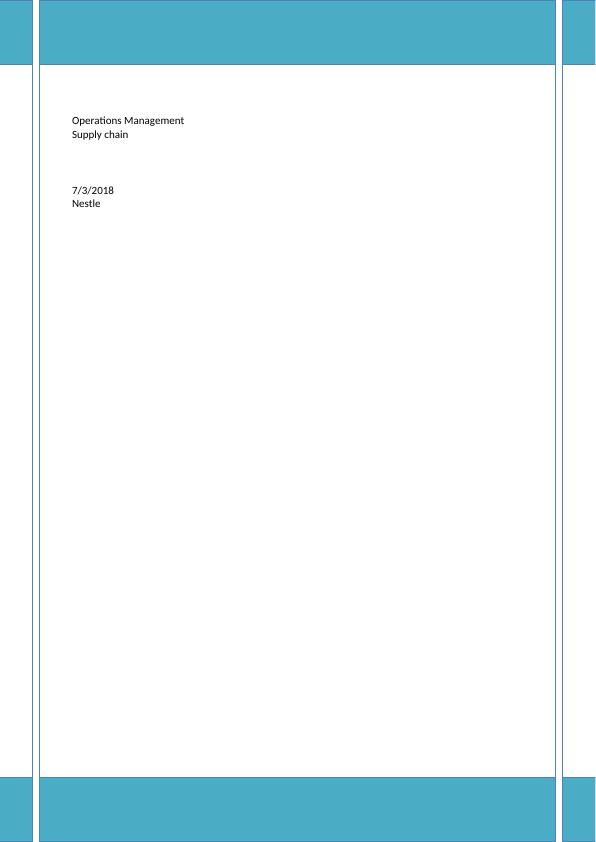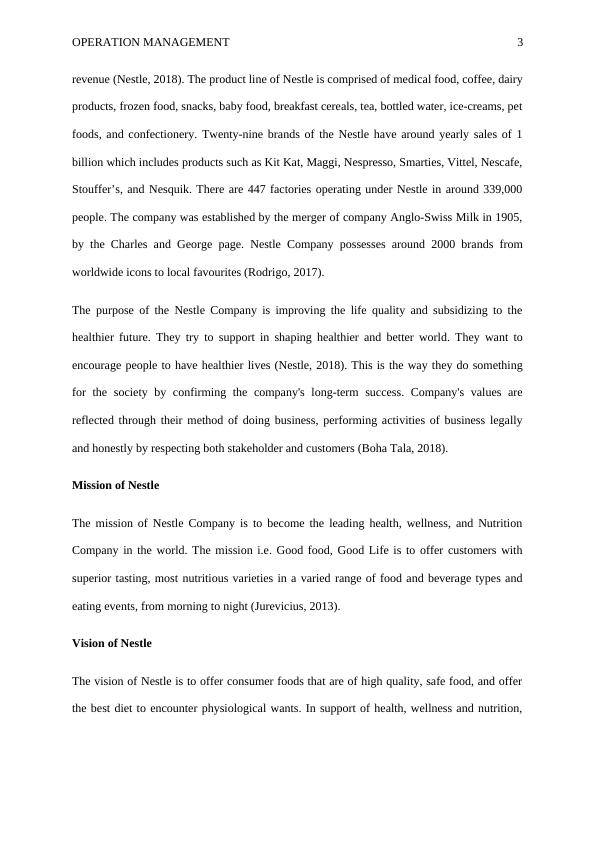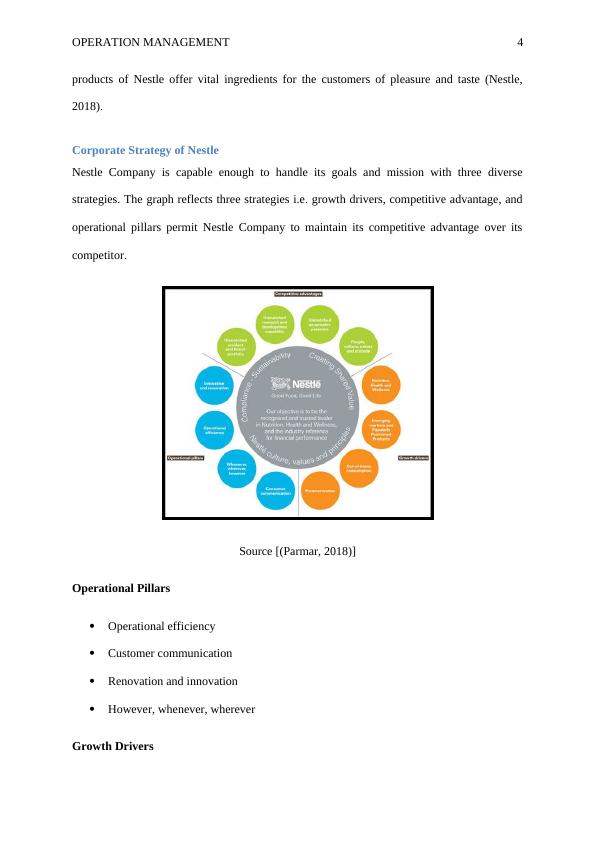Operations Management and Supply Chain at Nestle
Prepare a report evaluating the competitiveness of a chosen organization in achieving key strategic objectives by analyzing its supply chain networks, operations management, and quality management processes.
22 Pages5418 Words122 Views
Added on 2023-06-10
About This Document
This report discusses the operations management and supply chain strategies at Nestle, the world's largest food and drink company. It covers their corporate strategy, quality challenges, and PESTLE analysis. The report also delves into the importance of operations management in a business and how it can be used to maximize efficiency and profit.
Operations Management and Supply Chain at Nestle
Prepare a report evaluating the competitiveness of a chosen organization in achieving key strategic objectives by analyzing its supply chain networks, operations management, and quality management processes.
Added on 2023-06-10
ShareRelated Documents
Operations Management
Supply chain
7/3/2018
Nestle
Supply chain
7/3/2018
Nestle

OPERATION MANAGEMENT 1
Table of Contents
Introduction................................................................................................................................2
Overview of Nestle................................................................................................................2
Corporate Strategy of Nestle..............................................................................................4
Brief of Operation Strategy....................................................................................................6
Supply chain at Nestle............................................................................................................6
Quality challenges..............................................................................................................6
Present Operation Strategy.....................................................................................................7
Pestle Analysis of Nestle........................................................................................................9
Political Factor...................................................................................................................9
Economic Factors...............................................................................................................9
Social factors......................................................................................................................9
Technological Factor........................................................................................................10
Legal Factors....................................................................................................................10
Environmental factors......................................................................................................10
Supply Chain Management..................................................................................................10
Challenges of Supply chain management........................................................................11
Lean Management and Quality Management......................................................................13
Lean Management............................................................................................................13
Quality Management........................................................................................................14
Challenges of adopting a leaner enterprise......................................................................15
Artificial Intelligence...........................................................................................................15
Challenges of implementing Artificial Intelligence.........................................................16
Conclusion................................................................................................................................16
References................................................................................................................................18
Table of Contents
Introduction................................................................................................................................2
Overview of Nestle................................................................................................................2
Corporate Strategy of Nestle..............................................................................................4
Brief of Operation Strategy....................................................................................................6
Supply chain at Nestle............................................................................................................6
Quality challenges..............................................................................................................6
Present Operation Strategy.....................................................................................................7
Pestle Analysis of Nestle........................................................................................................9
Political Factor...................................................................................................................9
Economic Factors...............................................................................................................9
Social factors......................................................................................................................9
Technological Factor........................................................................................................10
Legal Factors....................................................................................................................10
Environmental factors......................................................................................................10
Supply Chain Management..................................................................................................10
Challenges of Supply chain management........................................................................11
Lean Management and Quality Management......................................................................13
Lean Management............................................................................................................13
Quality Management........................................................................................................14
Challenges of adopting a leaner enterprise......................................................................15
Artificial Intelligence...........................................................................................................15
Challenges of implementing Artificial Intelligence.........................................................16
Conclusion................................................................................................................................16
References................................................................................................................................18

OPERATION MANAGEMENT 2
Introduction
Operation management is the management of business practices to make the maximum level
of efficiency possible in a company. It is related to altering labour and materials into services
and goods as professionally as conceivable to increase the company’s profit (Mahadevan,
2015). The team of operations management tries to balance the costs with the revenue to
attain their maximum possible operating profit. This report is being prepared in order to
understand the concepts of supply chain network, quality management processes and
operations management in the organization. To do so the Nestle Company has been selected.
Moreover, it is very important to know the importance of operations management in a
business so that it can be used to the maximum level (Cooke, 2012). The shared certainty
amongst people was to accept that the operations management was essential just in the
industry of manufacturing. The trust was reinforced with the statement that the industry of
manufacturing need to take care of maximum number of operations and procedures
preliminary from procurement of the raw materials until the services or goods is traded. In
many situations after sales support was also measured hereafter making the trust that the
operations management is essential to the industry of manufacturing (Anastasia, 2016). In
terms of services industry, they possess numerous procedures involved beginning from
understanding the needs of the customer to receiving the feedback on the goods offered. Later
at a certain point, the industry of service tells the industry of manufacturing what they need
and hence to accomplish operations in the service industry it is significant to handle the
operations in the manufacturing industry (Nada Sanders, 2014).
Overview of Nestle
Nestle Company is one of the well-known company of food and drink with headquarter in
Switzerland. It is the biggest company of food in the whole world, measured in terms of
Introduction
Operation management is the management of business practices to make the maximum level
of efficiency possible in a company. It is related to altering labour and materials into services
and goods as professionally as conceivable to increase the company’s profit (Mahadevan,
2015). The team of operations management tries to balance the costs with the revenue to
attain their maximum possible operating profit. This report is being prepared in order to
understand the concepts of supply chain network, quality management processes and
operations management in the organization. To do so the Nestle Company has been selected.
Moreover, it is very important to know the importance of operations management in a
business so that it can be used to the maximum level (Cooke, 2012). The shared certainty
amongst people was to accept that the operations management was essential just in the
industry of manufacturing. The trust was reinforced with the statement that the industry of
manufacturing need to take care of maximum number of operations and procedures
preliminary from procurement of the raw materials until the services or goods is traded. In
many situations after sales support was also measured hereafter making the trust that the
operations management is essential to the industry of manufacturing (Anastasia, 2016). In
terms of services industry, they possess numerous procedures involved beginning from
understanding the needs of the customer to receiving the feedback on the goods offered. Later
at a certain point, the industry of service tells the industry of manufacturing what they need
and hence to accomplish operations in the service industry it is significant to handle the
operations in the manufacturing industry (Nada Sanders, 2014).
Overview of Nestle
Nestle Company is one of the well-known company of food and drink with headquarter in
Switzerland. It is the biggest company of food in the whole world, measured in terms of

OPERATION MANAGEMENT 3
revenue (Nestle, 2018). The product line of Nestle is comprised of medical food, coffee, dairy
products, frozen food, snacks, baby food, breakfast cereals, tea, bottled water, ice-creams, pet
foods, and confectionery. Twenty-nine brands of the Nestle have around yearly sales of 1
billion which includes products such as Kit Kat, Maggi, Nespresso, Smarties, Vittel, Nescafe,
Stouffer’s, and Nesquik. There are 447 factories operating under Nestle in around 339,000
people. The company was established by the merger of company Anglo-Swiss Milk in 1905,
by the Charles and George page. Nestle Company possesses around 2000 brands from
worldwide icons to local favourites (Rodrigo, 2017).
The purpose of the Nestle Company is improving the life quality and subsidizing to the
healthier future. They try to support in shaping healthier and better world. They want to
encourage people to have healthier lives (Nestle, 2018). This is the way they do something
for the society by confirming the company's long-term success. Company's values are
reflected through their method of doing business, performing activities of business legally
and honestly by respecting both stakeholder and customers (Boha Tala, 2018).
Mission of Nestle
The mission of Nestle Company is to become the leading health, wellness, and Nutrition
Company in the world. The mission i.e. Good food, Good Life is to offer customers with
superior tasting, most nutritious varieties in a varied range of food and beverage types and
eating events, from morning to night (Jurevicius, 2013).
Vision of Nestle
The vision of Nestle is to offer consumer foods that are of high quality, safe food, and offer
the best diet to encounter physiological wants. In support of health, wellness and nutrition,
revenue (Nestle, 2018). The product line of Nestle is comprised of medical food, coffee, dairy
products, frozen food, snacks, baby food, breakfast cereals, tea, bottled water, ice-creams, pet
foods, and confectionery. Twenty-nine brands of the Nestle have around yearly sales of 1
billion which includes products such as Kit Kat, Maggi, Nespresso, Smarties, Vittel, Nescafe,
Stouffer’s, and Nesquik. There are 447 factories operating under Nestle in around 339,000
people. The company was established by the merger of company Anglo-Swiss Milk in 1905,
by the Charles and George page. Nestle Company possesses around 2000 brands from
worldwide icons to local favourites (Rodrigo, 2017).
The purpose of the Nestle Company is improving the life quality and subsidizing to the
healthier future. They try to support in shaping healthier and better world. They want to
encourage people to have healthier lives (Nestle, 2018). This is the way they do something
for the society by confirming the company's long-term success. Company's values are
reflected through their method of doing business, performing activities of business legally
and honestly by respecting both stakeholder and customers (Boha Tala, 2018).
Mission of Nestle
The mission of Nestle Company is to become the leading health, wellness, and Nutrition
Company in the world. The mission i.e. Good food, Good Life is to offer customers with
superior tasting, most nutritious varieties in a varied range of food and beverage types and
eating events, from morning to night (Jurevicius, 2013).
Vision of Nestle
The vision of Nestle is to offer consumer foods that are of high quality, safe food, and offer
the best diet to encounter physiological wants. In support of health, wellness and nutrition,

OPERATION MANAGEMENT 4
products of Nestle offer vital ingredients for the customers of pleasure and taste (Nestle,
2018).
Corporate Strategy of Nestle
Nestle Company is capable enough to handle its goals and mission with three diverse
strategies. The graph reflects three strategies i.e. growth drivers, competitive advantage, and
operational pillars permit Nestle Company to maintain its competitive advantage over its
competitor.
Source [(Parmar, 2018)]
Operational Pillars
Operational efficiency
Customer communication
Renovation and innovation
However, whenever, wherever
Growth Drivers
products of Nestle offer vital ingredients for the customers of pleasure and taste (Nestle,
2018).
Corporate Strategy of Nestle
Nestle Company is capable enough to handle its goals and mission with three diverse
strategies. The graph reflects three strategies i.e. growth drivers, competitive advantage, and
operational pillars permit Nestle Company to maintain its competitive advantage over its
competitor.
Source [(Parmar, 2018)]
Operational Pillars
Operational efficiency
Customer communication
Renovation and innovation
However, whenever, wherever
Growth Drivers

OPERATION MANAGEMENT 5
Out of home consumption
Wellness, health, and nutrition
Premiumisation
Developing markets and status sited products
Competitive advantage
Unmatched development and research competence
Values, people, attitude, and culture
Unmatched brand portfolio and product
Unmatched geographic existence
All these are the strategies utilized by the Nestle Company in order to confirm that it
flourishes in the market. The thing that helps Nestle in becoming stronger as compared to
their competitors such as General Mills is its strong brand that is capable to make competitive
obstacles. In regards to their operational pillars, Company’s success arises from the
unbelievable marketing. Company’s marketing is dependent on the evidence that they are
capable to offer cheaper and quality priced products by offering satisfaction to the customers.
This arrives from their core health, wellness, and nutrition mission. Different from their rivals
marketing, Nestle Company is capable to provision their tough brands with their inducing
influences of nourishing products (Chystyakova, 2013).
Nestle Company has also gone above its rivals by utilizing its strategy of matchless
development and research competence. They have united with big corporations, for instance:
Coca-Cola. They also perform differently as compared to their rivals; Nestle Company has
attained native companies in order to make local managers who have the understanding of the
native culture and market. This permits them to attain a strategic advancement in the
Out of home consumption
Wellness, health, and nutrition
Premiumisation
Developing markets and status sited products
Competitive advantage
Unmatched development and research competence
Values, people, attitude, and culture
Unmatched brand portfolio and product
Unmatched geographic existence
All these are the strategies utilized by the Nestle Company in order to confirm that it
flourishes in the market. The thing that helps Nestle in becoming stronger as compared to
their competitors such as General Mills is its strong brand that is capable to make competitive
obstacles. In regards to their operational pillars, Company’s success arises from the
unbelievable marketing. Company’s marketing is dependent on the evidence that they are
capable to offer cheaper and quality priced products by offering satisfaction to the customers.
This arrives from their core health, wellness, and nutrition mission. Different from their rivals
marketing, Nestle Company is capable to provision their tough brands with their inducing
influences of nourishing products (Chystyakova, 2013).
Nestle Company has also gone above its rivals by utilizing its strategy of matchless
development and research competence. They have united with big corporations, for instance:
Coca-Cola. They also perform differently as compared to their rivals; Nestle Company has
attained native companies in order to make local managers who have the understanding of the
native culture and market. This permits them to attain a strategic advancement in the

End of preview
Want to access all the pages? Upload your documents or become a member.
Related Documents
Operation and Project Managementlg...
|27
|6368
|84
Etihad Airways: Operations Strategy and Supply Chain Management Analysislg...
|32
|9127
|341
Operation Strategies and Challenges of Lean in Nestlélg...
|12
|709
|59
MGT513 Supply Chain Management Nestle - Deskliblg...
|16
|3620
|3235
Logistics and Supply chain management Report 2022lg...
|9
|1761
|28
Global Logistics and Supply Chain Management of Nestlelg...
|13
|4427
|396
